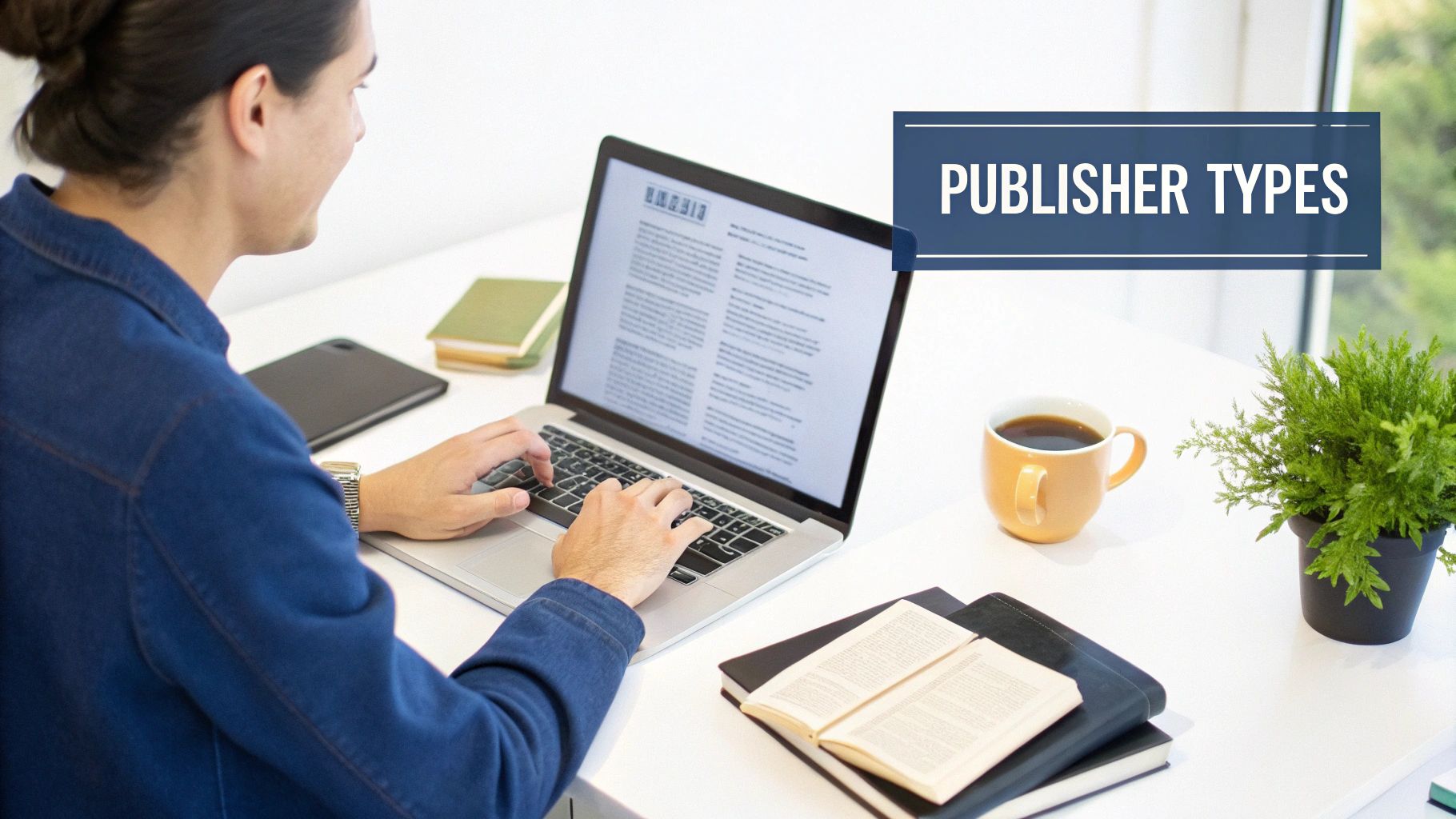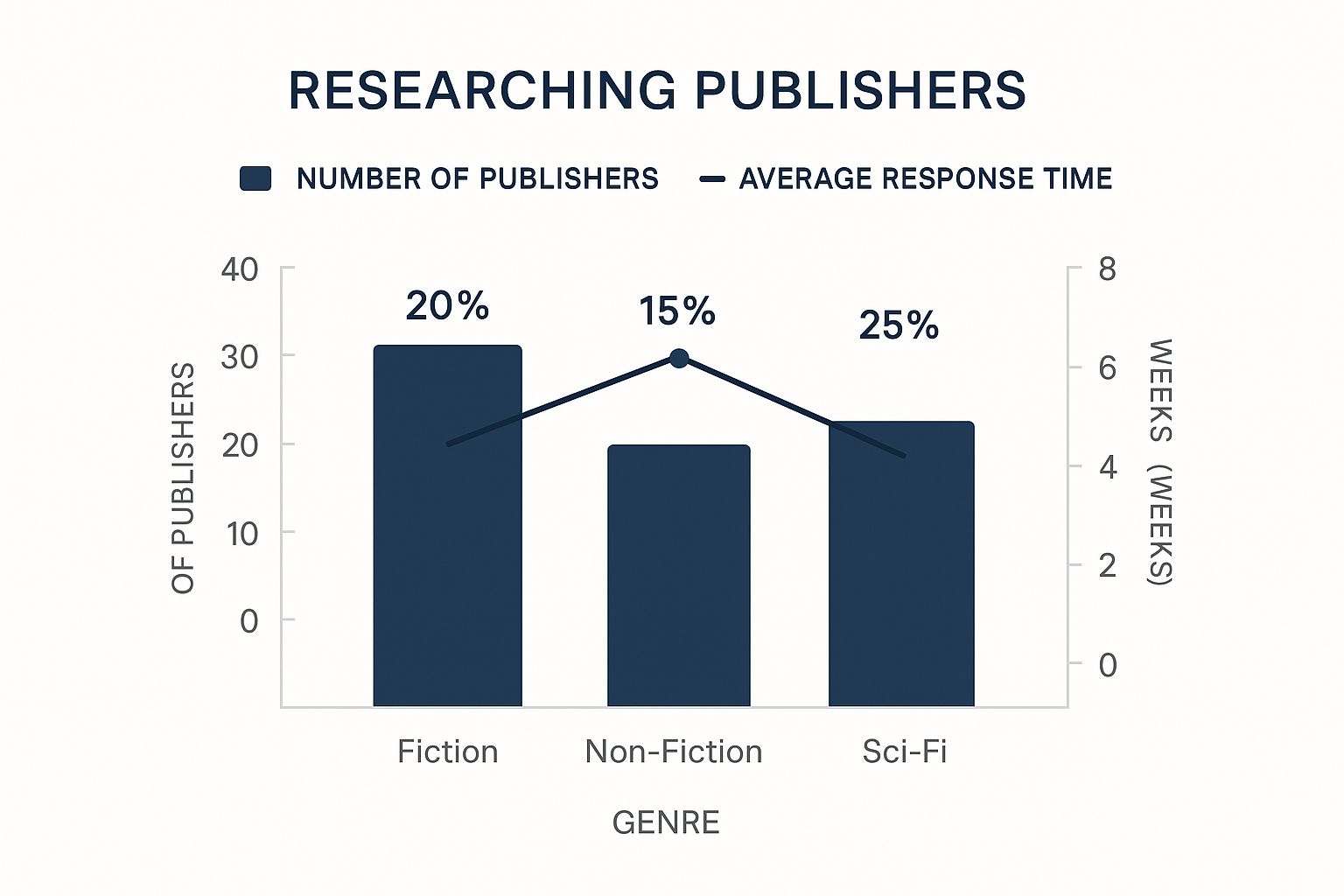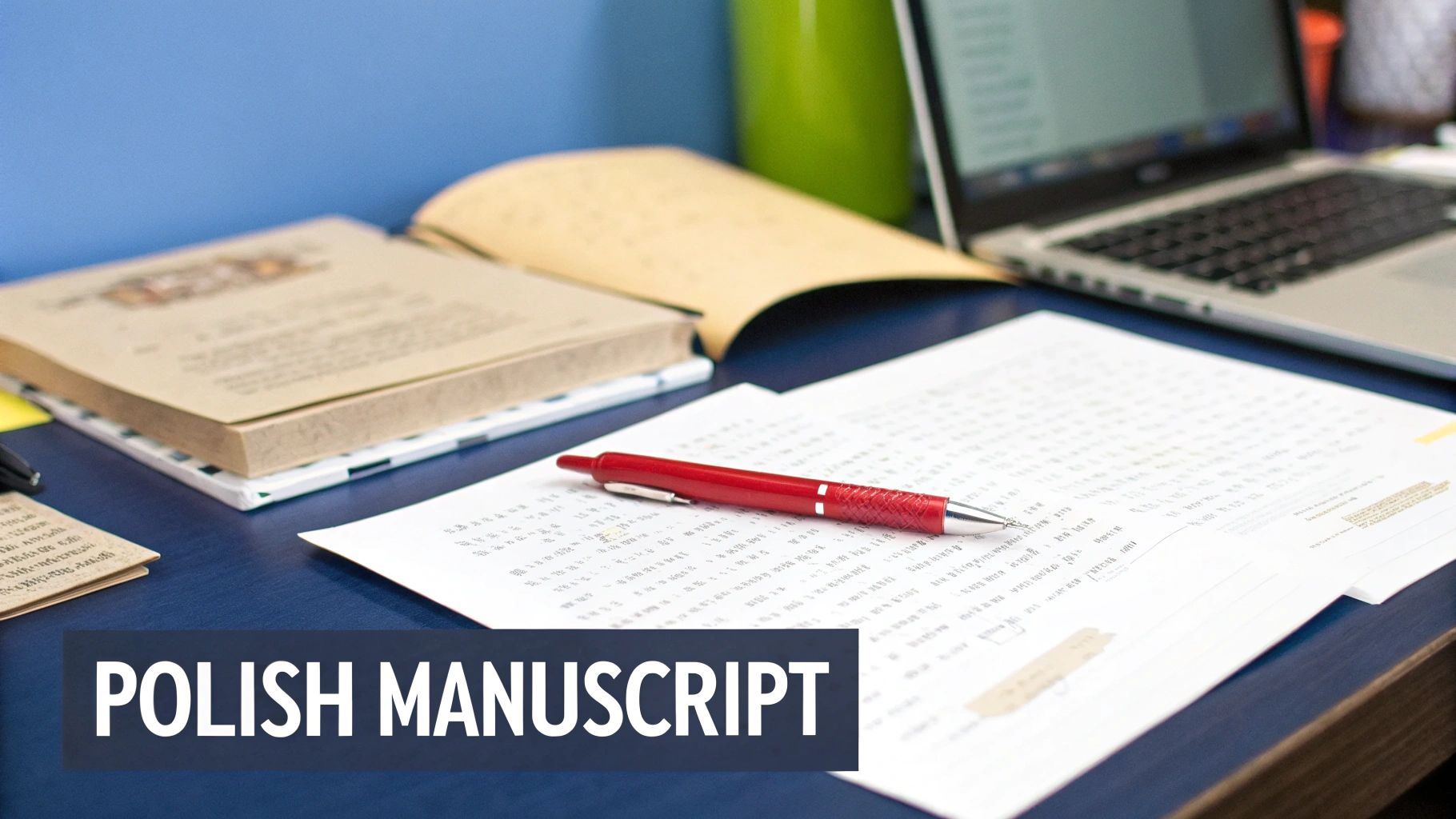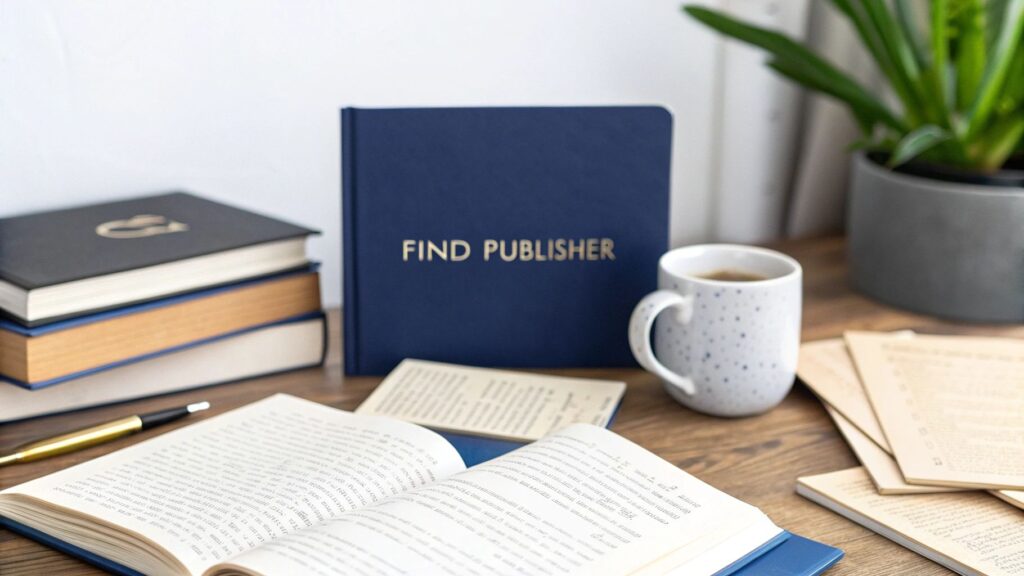Before you even dream of sending your manuscript to an agent or publisher, you have to get it professionally polished. This isn't just a friendly tip—it's the absolute baseline for getting taken seriously in traditional publishing. Sending out a raw first draft, no matter how amazing the story is, is a surefire way to get rejected.
Is Your Manuscript Really Ready for Submission?

It’s an incredible feeling to type those two magic words: "The End." But that moment, as huge as it is, isn't the finish line. It's the starting gun for the revision process, and this is where the real work of turning a story into a book begins.
It’s easy to fall into the trap of thinking your manuscript is "good enough," but in a world where publishers are drowning in submissions, "good enough" won't cut it. Your book needs to shine from the very first page, and that level of polish only comes from rigorous editing and critical feedback.
The Power of a Fresh Perspective
You've lived with your story for months, maybe even years. You're so close to it that spotting its flaws is nearly impossible. This is precisely why getting outside eyes on your work is so critical. The goal isn't to fish for compliments; it's to uncover the weak spots in your plot, character arcs, and pacing that you've become blind to.
A great first step is to gather a team of trusted readers. If you're looking for structured, helpful feedback, you might want to look into how to find beta readers for your book. These early readers are invaluable for pointing out what’s working and what isn’t.
"A polished, professionally edited manuscript is your non-negotiable entry ticket. It shows you respect the publisher's time and that you are a professional who takes their craft seriously."
Once you've reworked your draft based on beta reader feedback, it's time for the next crucial investment: professional editing. So many new authors try to skip this step, and frankly, it's a massive mistake. It sends a clear signal to publishers that you haven't put in the work to get your book market-ready.
Developmental vs. Copyediting
Knowing the difference between the types of editing will help you spend your money wisely. Each plays a distinct and vital role in whipping your manuscript into shape.
- Developmental Editing: Think of this as the "big picture" edit. A developmental editor digs into the bones of your story. They’ll look at plot structure, character development, pacing, and overall narrative strength to make sure your story is fundamentally solid and engaging.
- Copyediting: This is the nitty-gritty, line-by-line work. A copyeditor is your expert for correcting grammar, spelling, punctuation, and syntax. They clean up the prose to make it flawless, ensuring no distracting errors pull an editor out of the story.
To put it another way, a developmental editor might tell you your main character’s motivation in chapter three is unconvincing. A copyeditor, working on that same chapter, would fix the clunky sentence you used to describe it. You need both to create a manuscript that commands attention.
Getting to Know the Modern Publishing World
So, you've written a book. The next big question is, how do you find the right publisher? It all starts with a deep dive into the business itself. The publishing industry isn't just about finding the next great story; it’s a business driven by market demand, sales data, and what’s currently resonating with readers.
Knowing the lay of the land is what separates the authors who get noticed from those who languish in the slush pile. You might think digital is everything these days, but the industry's foundation is still surprisingly traditional. For instance, a recent report on the U.S. market showed that print books still bring in the lion's share of revenue, hitting an incredible $4.1 billion in the first four months of the year alone.
Finding Your Book's Place in the Market
What does that number actually mean for you? It's a clear signal that publishers are still betting big on physical books, even with the undeniable growth of ebooks and audiobooks.
Hardcover sales, for example, recently jumped by a healthy 4.4%, while ebooks saw a more moderate 3.5% increase. This isn't just random data; it’s a map showing you where the real money and opportunities are. At the end of the day, a publisher's job is to sign books they believe will sell. Your pitch needs to show them you get that. If you want a closer look at their role, you can learn more about what a publisher actually does here: https://barkerbooks.com/what-does-a-book-publisher-do/.

As you can see, some of the most popular genres have a ton of publishers, but that also means they have much lower acceptance rates and you might be waiting a lot longer for a response. It’s a classic trade-off you’ll need to weigh.
To help you decide where to focus your efforts, here's a quick look at how different book formats have been performing.
Publishing Format Market Snapshot
This table summarizes recent performance across different book formats to guide your publishing strategy.
| Book Format | Recent Sales Trend | Author Consideration |
|---|---|---|
| Hardcover | Strong growth (4.4% increase) | Still the gold standard for major releases and pre-orders. |
| Paperback | Stable and consistent | The workhorse of the industry, great for reaching a wider audience. |
| Ebook | Modest growth (3.5% increase) | An essential part of any launch, but not the only one. |
| Audiobook | Steady, continued growth | A rapidly expanding market with a dedicated and growing audience. |
This data confirms that a multi-format approach is often the smartest play. While digital is important, overlooking the power of print would be a huge mistake.
Start Thinking Like a Publisher
A publisher isn't just buying a manuscript; they're investing in a marketable product with a built-in audience. When you can talk their language and show you've done your homework, you immediately stand out.
A publisher needs to see more than just a great story. They need to see a solid business case. Proving you understand sales trends shows you're a serious partner, not just another aspiring writer.
This means your research has to go way beyond just finding a list of publishers in your genre. You need to dig into what's working for them right now.
- Scour the Bestseller Lists: Who's consistently putting books like yours at the top? Pay attention to the genres, themes, and even the cover art.
- Study Their Websites: Check out the "New Releases" or "Our Authors" sections on publisher websites. This gives you a direct window into what they’re excited about promoting.
- Follow the Trades: Publications like Publishers Weekly are goldmines for information on recent deals and acquisitions, telling you who’s buying what.
As you get a feel for the industry, it's also a good time to start understanding media relations. Publishers love authors who already have a platform or, at the very least, a smart plan to build one. Showing them you're ready to help market your own book can be the thing that seals the deal.
Crafting a Submission Package That Stands Out

Your submission package is your first—and often only—shot to convince an agent or publisher to take a chance on you. Think of it as your book's audition. It’s not just about the manuscript; it’s about proving you're a professional who understands the business of publishing.
A sloppy, one-size-fits-all package screams amateur. On the other hand, a polished, thoughtful submission shows you're serious and respect their time. That alone puts you ahead of a huge portion of the slush pile. This is where you make your case before they’ve even read a word of your story.
The Anatomy of a Killer Query Letter
The query letter is the heart of your submission. It has one job: to make an agent stop scrolling through their inbox and request your manuscript. You've got about 300 words to hook them, pitch your story, and sell yourself. Forget a dry summary—this is a sales pitch.
Every great query letter I've ever seen nails three things:
- The Hook: Your opening. It’s a one or two-sentence teaser that boils your book down to its core conflict and stakes. It has to be punchy.
- The Mini-Synopsis: A tight paragraph introducing your protagonist, what they want, what's stopping them, and what happens if they fail. This gives a sense of your book's tone and voice.
- The Bio: A quick blurb about you. Include relevant writing credits, the size of your author platform, and why you were the perfect person to write this book.
Nailing this takes revision. Lots of it. If you're struggling to get the structure right, using a solid query letter template to guide your writing can be a lifesaver. Just remember to personalize it; always address the agent by name and mention why you're querying them specifically.
Writing a Synopsis That Sells, Not Spoils
Next up is the synopsis. This is a complete summary of your plot, from the first page to the last—and yes, you have to spoil the ending. Its purpose isn't to build suspense but to prove to the agent that your story works and has a marketable structure. Keep it to one or two pages, max, and write in the third person.
The most common trap authors fall into here is getting lost in the weeds. Don't describe every subplot or minor character. Stick to the main storyline and your protagonist's emotional journey. Your synopsis is the blueprint that proves your story is well-built.
Even though it’s a summary, your voice should still shine through. Don’t let it read like a Wikipedia entry. A synopsis infused with your unique style gives them a taste of what it will be like to read the actual manuscript.
Your Author Bio: Building Credibility
Finally, your author bio is where you build trust. Have you been published before? Won any awards? Have a professional background that gives your story authenticity? Put it all here. If you're a thriller author who works in cybersecurity, that's instant credibility.
Don't panic if you're just starting out and don't have a long list of achievements. You can build credibility in other ways. Talk about your social media following, the traffic your blog gets, or any experience with public speaking. Publishers are looking for partners, not just writers. Showing you already have an audience, no matter the size, is a huge plus.
Alright, you've polished your manuscript and your submission materials are looking sharp. Now comes the real detective work: finding the right literary agent.
Think of this process less like casting a wide net and more like a targeted strike. Blasting out a generic query to every agent you can find is a fast track to the slush pile. What really gets an agent's attention is a submission that shows you’ve done your homework.
When an agent sees a query that mentions authors they represent or books they've sold that are in the same vein as yours, it immediately stands out. It tells them you're a professional who understands their unique taste and isn't just throwing spaghetti at the wall to see what sticks.
Building Your Agent Shortlist
The first order of business is to create a carefully curated list of agents who are actively looking for books in your specific genre. It’s not enough to find someone who represents "fiction." You need to drill down. An agent who’s known for selling gritty crime thrillers probably isn’t the right person for your sweeping historical romance.
Here are a few of the best places to start your search:
- Publishers Marketplace: This is the industry's home base. A subscription is an investment, but it gives you an incredible window into who is selling what, to which editors, and at what publishers. It’s invaluable.
- AgentQuery & QueryTracker: These free (with paid premium options) databases are fantastic for filtering agents by genre and checking their submission status. They're great for organizing your search and discovering agents you might have otherwise missed.
- Author Acknowledgments: This is a classic, old-school move that still works wonders. Grab a few books from your shelf that feel like a great comparison for your own. Flip to the acknowledgments page. Authors almost always thank their agent by name, giving you a perfect lead.
Pro Tip: Don't just rely on what an agent says they want on their website. Look at what they actually sell. An agent's deal history on Publishers Marketplace is the truest indicator of their current taste and industry connections.
Vetting Your Prospects and Their Publishers
Once you've got a solid list of potential agents, it's time to put on your investigator hat and start narrowing it down. Head over to each agent’s website or their agency's site and read their submission guidelines with meticulous care. Pay close attention to what they’re looking for, and even more importantly, what they explicitly say they are not looking for.
This is all about finding that perfect match. As you research, look at the publishers they sell to most often. Do those publishing houses release books similar to yours? If an agent consistently sells to imprints known for high-concept commercial thrillers, they might not be the best champion for your quiet, literary novel, no matter how much they like it personally.
Your goal is to find that sweet spot—the perfect intersection where an agent's passion aligns with a publisher's current needs.
Navigating Self-Publishing and Hybrid Models

The journey to getting your book into the hands of readers isn't a single, straight path anymore. While landing a traditional publishing deal is still a major goal for many writers, it's so important to understand how the game has changed. Self-publishing has grown from a fringe option into a powerful, strategic choice for countless successful authors.
The industry looks completely different than it did a decade ago. The sheer volume of independently published books is staggering—in a recent year, around 500,000 new self-published titles hit the market in the U.S. alone. Now, compare that to the fact that traditional publishers accept maybe 2% of the unsolicited manuscripts they receive. Suddenly, that alternative route looks a lot more like the main road for many of us. If you want to dive deeper, you can explore more on these self-publishing statistics to see the full picture.
What this really means is that launching your book on your own can be the ultimate proof of concept. Nothing gets a traditional publisher's attention faster than a self-published book that's already selling and has a built-in audience.
Weighing Your Independent Options
Deciding to self-publish puts you squarely in the CEO chair of your author career. It's an incredibly empowering path with some massive upsides, but it also comes with a hefty dose of responsibility. Before you jump in, you need to be honest with yourself about the trade-offs.
Here’s what makes self-publishing so attractive to many writers:
- Total Creative Control: You call all the shots. The cover design, the interior formatting, the title, the back cover copy—every single decision is yours. Your vision stays yours.
- Higher Royalty Rates: This is a big one. Without a publishing house taking a significant cut, you earn a much larger piece of the pie from every sale. For authors who can cultivate a loyal following, this can be incredibly profitable.
- Faster Time to Market: The traditional publishing timeline is notoriously slow, often taking years from signing a contract to seeing your book on a shelf. With self-publishing, you can move from a finished manuscript to a live book in a few months, sometimes even weeks.
A successful self-published book isn't just a book; it's a business. It demonstrates to traditional publishers that you have a viable product with a built-in audience, drastically reducing their investment risk.
Of course, the flip side of all that control is that you have to do everything. You’re not just the writer. You’re the publisher, the marketer, the project manager, and the accountant.
Understanding Hybrid Publishing
For authors who find themselves somewhere in the middle, a third option has become popular: hybrid publishing. Think of it as a blend of the traditional and self-publishing worlds. These companies offer professional services—like editing, design, and distribution—that you pay for. In exchange, you usually keep higher royalty rates than you would in a traditional deal.
This model can be a great fit if you want professional guidance but don't want to sign away all your creative control or the majority of your earnings. But a word of caution: you have to do your homework. Vet any hybrid publisher's reputation, check their past projects, and read their contracts with a fine-toothed comb. The goal is to find a true partner, not a "vanity press" in disguise. It all comes down to finding the path that best matches your personal goals, your budget, and how much of the business you're ready to run yourself.
So, you got the email. The one you’ve been waiting for. A publisher is interested, and they've sent an offer. It’s a huge moment, a massive milestone in any writer's career. But before you pop the champagne, take a deep breath. This isn't the finish line; it’s the starting line for negotiations.
That initial offer is exactly that—an opening bid. It lays out the publisher's first position on everything from your advance and royalty rates to marketing promises and subsidiary rights. Never feel pressured to sign the first thing you see. This is precisely why having a literary agent is so critical; they live and breathe these negotiations and will fight to get you the best possible deal.
Understanding the Modern Deal
The publishing world has changed a lot in recent years. Many publishers are moving away from the massive, speculative advances of the past and embracing more sustainable, profit-sharing models. We're seeing more and more deals where authors are offered a higher percentage of revenue from book sales over the long haul.
What does this mean for you? It means that publishers are looking for authors who come to the table with a strong personal brand and a proven audience. They want partners, not just manuscripts. You can read more about these publishing trends to get a better sense of where the industry is heading.
This shift isn't a bad thing. A smaller advance might feel like a letdown initially, but a contract with higher royalty rates could translate into far greater earnings down the road, especially if your book finds its audience and sells well.
An advance is just a loan against your future royalties. A fair contract that gives you a bigger slice of the pie can be infinitely more valuable than a big, splashy check that your book might never even earn out.
Key Contract Terms to Scrutinize
When that offer lands, you need to pore over the contract. It’s vital to understand intellectual property rights and violations to make sure your work is protected. Publishing contracts are notoriously long and dense, but there are a few key areas that demand your undivided attention.
- Rights Granted: What rights are you actually selling? Are they asking for world rights, or just for North America? What about film, audiobook, and translation rights? The goal is to hold onto as many as you can, as these can become separate, valuable income streams later.
- Royalty Structure: Look very closely at the percentages. Hardcover, paperback, and ebook royalty rates can be wildly different, and these numbers will directly impact your long-term earnings.
- Marketing Commitment: What is the publisher actually going to do to sell your book? A good contract will have specific, tangible commitments outlining their marketing plan and budget. Vague promises aren't enough.
A publishing deal is a long-term partnership. You want to walk into an agreement that feels transparent, fair, and positions your book for the absolute best chance at success. This is your career—make sure you get it right.
At BarkerBooks, we help authors navigate this entire journey. From getting your manuscript into shape to providing contract negotiation support and building a global marketing strategy, we're here to give your book the professional launch it deserves. Turn your manuscript into a published success with us.
